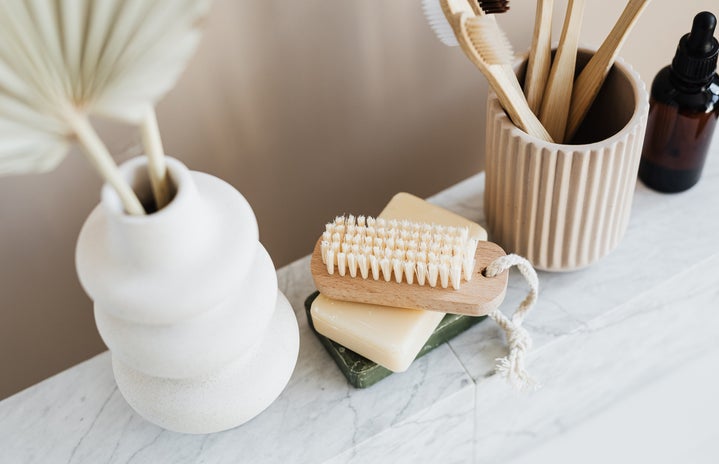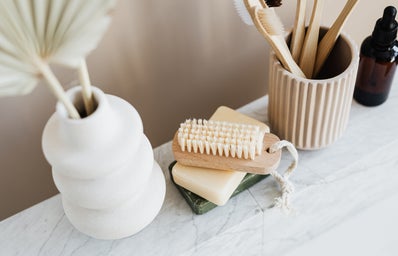In the last article, I focused on the kitchen, but we’re looking at the bathroom this week, another space that creates a lot of waste in our homes. It has definitely been a long process implementing some of these changes because I wait to change out items until I’ve used up everything I already own. Still, it has been gratifying to see the changes come together.
- At the Sink
-
One of the primary ways to make the bathroom more sustainable is switching toothbrushes. Electric toothbrushes still use disposable heads, so alternatively, bamboo toothbrushes with recyclable bristles. The brush’s body can be composted, plus bamboo is a sustainable material to grow and use. In addition to changing toothbrushes, I chose to switch to tablet toothpaste which has a lower emission cost to transport since they don’t contain liquid. They also are great for people that are sensitive to chemicals in toothpaste and are better at whitening (in my opinion) than other whitening toothpaste.
- In the Shower
-
An obvious change in the shower is bar soap over liquid, but changing to bar shampoo was a more difficult task because I have an oily scalp and most are made for normal or dry hair. After finally finding a few options, I made the switch, and my hair is healthier than it has been in years, and a bar lasts me longer than the liquid alternative. My next step will be trying out bar conditioners and face wash too. Razors are also a source of a lot of trash, so I’ve switched to a replaceable blade and use soap instead of buying shaving cream.
- The Toilet
-
So I haven’t used toilet paper since September because I bought a bidet and I will never go back. Not only is it more sanitary, but the lack of environmental impact is astounding by not using a product that is made to be disposed of from nonrenewable sources. In addition to that change, I have used a menstrual cup instead of tampons for the last four years. I won’t even get started on the issues that tampons create, but the change has saved so much money and is more manageable in daily life than worrying about carrying tampons.
- Vanity
-
A source of a lot of waste came from my vanity. Between packaging for necessities and cotton rounds and swabs, I could easily throw away a small trash can of the stuff in a week. One of the ways I’ve reduced my consumption is through reusable cotton rounds and a reusable swab. Additionally, considering what my products’ packaging is composed of has led me to switch to a refillable and bar deodorant and dry shampoo paste. These options use less packaging and don’t contribute to the issue of aerosol cans. Plus, using a dry shampoo paste actually works better at reducing the scalp’s oils than an aerosol option.
Although I’ve made these changes, I am still by no means perfect, and there will always be areas that I can work on to minimize and reduce my impact on the environment. I still use liquid conditioners for deep conditioning because the ends of my hair are quite dry. Finally, as far as skincare goes, I always use a variety of liquid products because there aren’t any alternatives. However, I am more particular about the products I buy as far as packaging, opting for glass over plastic. It’s been an exciting journey swapping out things for more eco-friendly products, and I’m happy to have you come along with me! Hit me up on Instagram if you have any recommendations for products or swap I haven’t talked about yet! Maybe add your instagram user here


